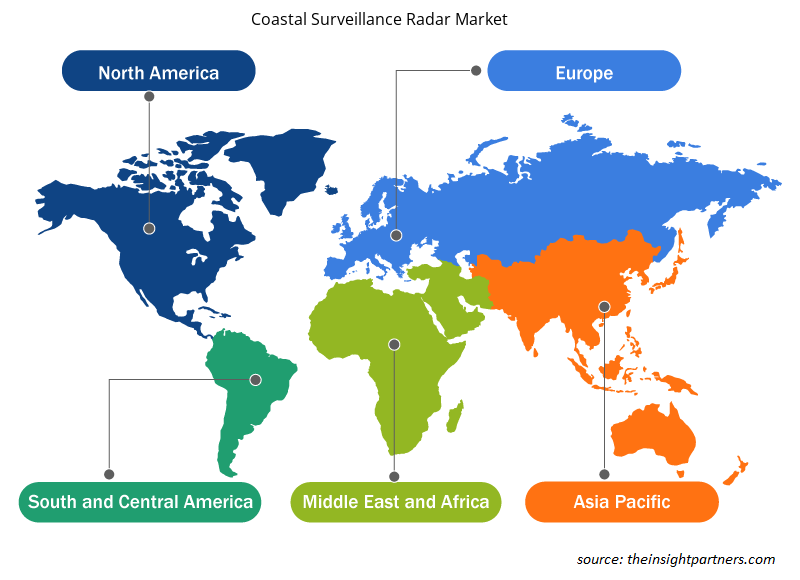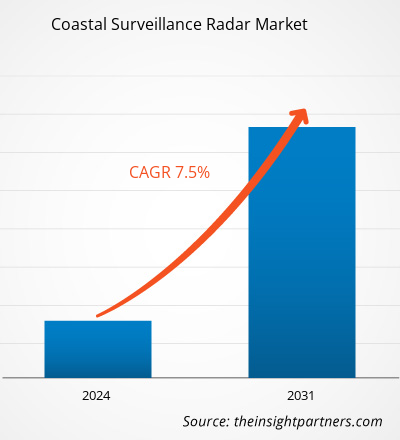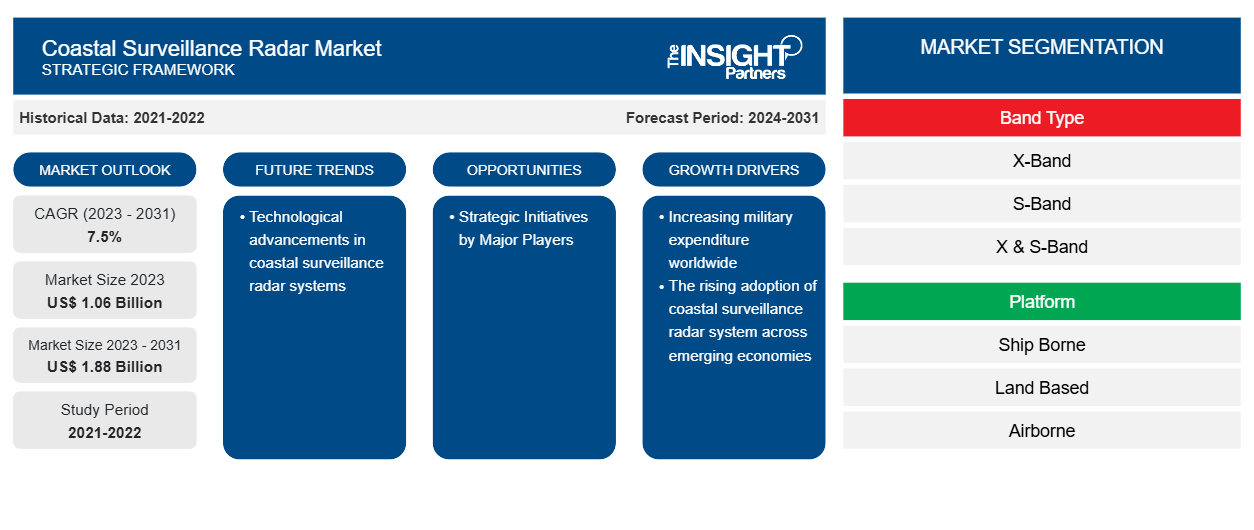沿岸監視レーダー市場規模は、2023年の10億6,000万米ドルから2031年には18億8,000万米ドルに達すると予測されています。市場は2023年から2031年の間に7.5%のCAGRを記録すると予想されています。沿岸監視レーダーシステムの技術的進歩は、今後も市場の主要なトレンドであり続けると思われます。
沿岸監視レーダー市場分析
Elbit Systems Ltd、Thales Group、Israel Aerospace Industries、Hensoldt AG、Terma A/S は、世界の沿岸監視レーダー市場で活動する主要な市場プレーヤーの一部です。これらの企業は、さまざまなエンドユーザー向けに、X バンド、S バンド、X および S バンド レーダーなどの堅牢なシステムの開発に取り組んでいます。さらに、これらの企業は、さまざまな海軍、沿岸警備隊、石油およびガス会社、港湾から、自社のレーダーに関する多数の契約を獲得しています。これらの企業は、沿岸監視レーダー製品の供給をサポートするためにエンドユーザーと長期契約を締結しており、これにより毎年収益を上げることができます。
沿岸監視レーダー市場の概要
世界の沿岸監視レーダー市場のエコシステムにおける主要な利害関係者には、部品メーカー、システム インテグレーター、エンド ユーザーなどが含まれます。沿岸監視システム レーダーは、システム メーカーが膨大な数の部品メーカーから調達するさまざまな部品で構成されています。これらの部品メーカーは、世界の沿岸監視レーダー プレーヤーに基本部品を供給します。システム インテグレーターは、各部品を統合した後、最終的な監視レーダー システムの製造に携わる企業です。世界の沿岸監視レーダー市場のエンド ユーザーには、沿岸で事業を行っている統治機関と民間組織の両方が含まれます。沿岸にある陸上の多国籍石油ガス会社は、業務と資産の安全性とセキュリティを確保するために、監視レーダーに大きく依存しています。一方、先進国と発展途上国による軍事費の増加と、麻薬密売、テロ、不法移民などの要因から陸上と沿岸の国境を守るための投資の増加も、政府機関による沿岸監視レーダーの採用を促進しています。
要件に合わせてレポートをカスタマイズする
このレポートの一部、国レベルの分析、Excelデータパックなど、あらゆるレポートを無料でカスタマイズできます。また、スタートアップや大学向けのお得なオファーや割引もご利用いただけます。
-
このレポートの主要な市場動向を入手してください。この無料サンプルには、市場動向から見積もりや予測に至るまでのデータ分析が含まれます。
沿岸監視レーダー市場の推進要因と機会
新興国における沿岸監視レーダーシステムの導入増加
中国、インド、台湾、韓国、ロシア、ウクライナ、イスラエル、パレスチナ、イランなどの新興経済国における国境の脅威の高まりにより、沿岸監視レーダーシステムの採用が促進されると予想されています。海上戦争や海洋反乱の増加により、これらの経済国の沿岸地域はますます重要になり、監視レーダーはリアルタイムで脅威を検出する上で重要な役割を果たしています。指揮官は、沿岸境界に沿って高度なレーダーシステムを配備することで、敵の動きとその周囲に関する貴重な洞察を得て、リアルタイムデータに基づいて必要な対策を講じることができます。鮮明で高解像度の画像でリアルタイムデータを収集するというこの利点は、エンドユーザーにとって決定的な魅力です。したがって、重要なパラメータを背景に、沿岸監視レーダー市場は世界中で成長しています。
主要プレーヤーによる戦略的取り組み
沿岸監視レーダー市場で事業を展開する企業は、多額の投資、製品の提供、世界的な拡大などの有機的および無機的な成長戦略を採用しており、世界の沿岸監視レーダー市場の成長機会をさらに創出しています。注目すべきいくつかの重要な動向は次のとおりです。
- 2022年9月、米国沿岸警備隊は、ミノタウロスのミッション化プロセス中に新しいC-130Jスーパーハーキュリーズ長距離監視機に搭載される最大5台のAN/APY-11マルチモードレーダーの契約をL3ハリステクノロジーズ社に授与しました。固定価格契約は、沿岸警備隊艦隊の18、19、20番目のC-130J航空機のミッション化とブロック8.1アップグレード中に、テキサス州ウェイコのL-3コミュニケーションインテグレーテッドシステムズによって搭載される3台のマルチモードレーダーの納入に関するものです。
- 2022年12月、LIG Nex1社は海軍兵站司令部と海洋監視レーダーIIプロジェクトに関する契約を締結しました。
こうした発展により、さまざまな地域の市場ベンダーに新たな機会が生まれています。
沿岸監視レーダー市場レポートのセグメンテーション分析
沿岸監視レーダー市場分析の導出に貢献した主要なセグメントは、バンドタイプ、プラットフォーム、およびエンドユーザーです。
- 帯域タイプに基づいて、沿岸監視レーダー市場は、Xバンド、Sバンド、X / Sバンド、その他に分類されます。Xバンドセグメントは2023年に大きな市場シェアを占めました。
- プラットフォームに基づいて、沿岸監視レーダー市場は、船舶搭載型、陸上型、空中型に分類されます。空中型セグメントは、2023年に大きな市場シェアを占めました。
- エンドユーザーに基づいて、沿岸監視レーダー市場は港湾石油・ガス会社と海上パトロール機関に分類されます。海上パトロール機関セグメントは2023年に大きな市場シェアを占めました。
沿岸監視レーダーの地域別市場シェア分析
沿岸監視レーダー市場レポートの地理的範囲は、主に北米、ヨーロッパ、アジア太平洋、中東およびアフリカ、南米の 5 つの地域に分かれています。
2023年には北米が市場を支配し、ヨーロッパとアジア太平洋地域がそれに続きます。さらに、アジア太平洋地域も今後数年間で最高のCAGRを記録する可能性があります。米国は、北米の沿岸監視レーダー市場で最大の市場シェアを占めています。米国はまた、技術的に先進的な国であり、長年にわたって新しい技術を採用する大きな可能性を秘めています。全国に存在する石油およびガス会社も、海岸線全体での事業の安全を確保するための技術を採用する大きな可能性を秘めています。これは、国全体での違法行為を制限または規制するための沿岸監視レーダーの採用にさらに影響を与えています。Accipiter Radar Technologies Inc、Teledyne FLIR LLC、L3Harris Technologies Inc、Raytheon Technologies Corporation、およびSSR Engineeringは、米国市場で活動しているプレーヤーの一部です。
沿岸監視レーダー市場の地域別分析
予測期間を通じて沿岸監視レーダー市場に影響を与える地域的な傾向と要因は、Insight Partners のアナリストによって徹底的に説明されています。このセクションでは、北米、ヨーロッパ、アジア太平洋、中東、アフリカ、南米、中米にわたる沿岸監視レーダー市場のセグメントと地理についても説明します。

- 沿岸監視レーダー市場の地域別データを入手
沿岸監視レーダー市場レポートの範囲
| レポート属性 | 詳細 |
|---|---|
| 2023年の市場規模 | 10億6千万米ドル |
| 2031年までの市場規模 | 18億8千万米ドル |
| 世界のCAGR(2023年~2031年) | 7.5% |
| 履歴データ | 2021-2022 |
| 予測期間 | 2024-2031 |
| 対象セグメント |
バンドタイプ別
|
| 対象地域と国 |
北米
|
| 市場リーダーと主要企業プロフィール |
|
沿岸監視レーダー市場のプレーヤー密度:ビジネスダイナミクスへの影響を理解する
沿岸監視レーダー市場は、消費者の嗜好の変化、技術の進歩、製品の利点に対する認識の高まりなどの要因により、エンドユーザーの需要が高まり、急速に成長しています。需要が高まるにつれて、企業は提供を拡大し、消費者のニーズを満たすために革新し、新たなトレンドを活用し、市場の成長をさらに促進しています。
市場プレーヤー密度とは、特定の市場または業界内で活動している企業または会社の分布を指します。これは、特定の市場スペースに、その市場規模または総市場価値に対してどれだけの競合相手 (市場プレーヤー) が存在するかを示します。
沿岸監視レーダー市場で事業を展開している主要企業は次のとおりです。
- Accipiter Radar Technologies Inc
- アセルサン AS
- ブライター監視システム株式会社
- イーサットレーダーシステムズ株式会社
- エルビットシステムズ株式会社
- テレダインFLIR LLC
免責事項:上記の企業は、特定の順序でランク付けされていません。

- 沿岸監視レーダー市場のトップキープレーヤーの概要を入手
沿岸監視レーダー市場のニュースと最近の動向
沿岸監視レーダー市場は、主要な企業出版物、協会データ、データベースなどの一次調査と二次調査後の定性的および定量的データを収集することによって評価されます。沿岸監視レーダー市場の動向のいくつかを以下に示します。
- レオナルドは、海上、航空、陸上部門向けの小型・中型3Dレーダー、電気光学センサー、慣性システムの製造を専門とするイタリア企業、GEM elettronicaの株式30%を取得しました。(出典:レオナルド、プレスリリース、2021年4月)
- センサーソリューションプロバイダーのHENSOLDTは、米国沿岸警備隊の「レジェンド」級国家安全保障カッター(NSC)に、実績のあるTRS-3Dマルチモード海軍レーダーを搭載しています。米国沿岸警備隊は、カリフォルニア州ペタルマの沿岸警備隊訓練センター(TRACEN)に設置される最新の「ベースラインD」バージョンのレーダーをさらに納入するため、HENSOLDTに約1,000万ドル相当の追加契約を授与しました。これまでに、HENSOLDTは米国沿岸警備隊のNSCプログラムに12台のレーダーを納入しています。(出典:HENSOLDT、プレスリリース、2023年9月)
沿岸監視レーダー市場レポートの対象範囲と成果物
「沿岸監視レーダー市場規模と予測(2021〜2031年)」レポートでは、以下の分野をカバーする市場の詳細な分析を提供しています。
- 対象範囲に含まれるすべての主要市場セグメントについて、世界、地域、国レベルでの沿岸監視レーダー市場規模と予測
- 沿岸監視レーダー市場の動向、推進要因、制約、主要な機会などの市場動向
- ポーターの5つの力の詳細な分析
- 沿岸監視レーダー市場分析では、主要な市場動向、世界および地域の枠組み、主要プレーヤー、規制、最近の市場動向を取り上げています。
- 沿岸監視レーダー市場の市場集中、ヒートマップ分析、主要プレーヤー、最近の動向を網羅した業界展望と競争分析
- 詳細な企業プロフィール
- 過去2年間の分析、基準年、CAGRによる予測(7年間)
- PEST分析とSWOT分析
- 市場規模価値/数量 - 世界、地域、国
- 業界と競争環境
- Excel データセット
最新レポート
関連レポート
お客様の声
購入理由
- 情報に基づいた意思決定
- 市場動向の理解
- 競合分析
- 顧客インサイト
- 市場予測
- リスク軽減
- 戦略計画
- 投資の正当性
- 新興市場の特定
- マーケティング戦略の強化
- 業務効率の向上
- 規制動向への対応























 無料サンプルを入手 - 沿岸監視レーダー市場
無料サンプルを入手 - 沿岸監視レーダー市場